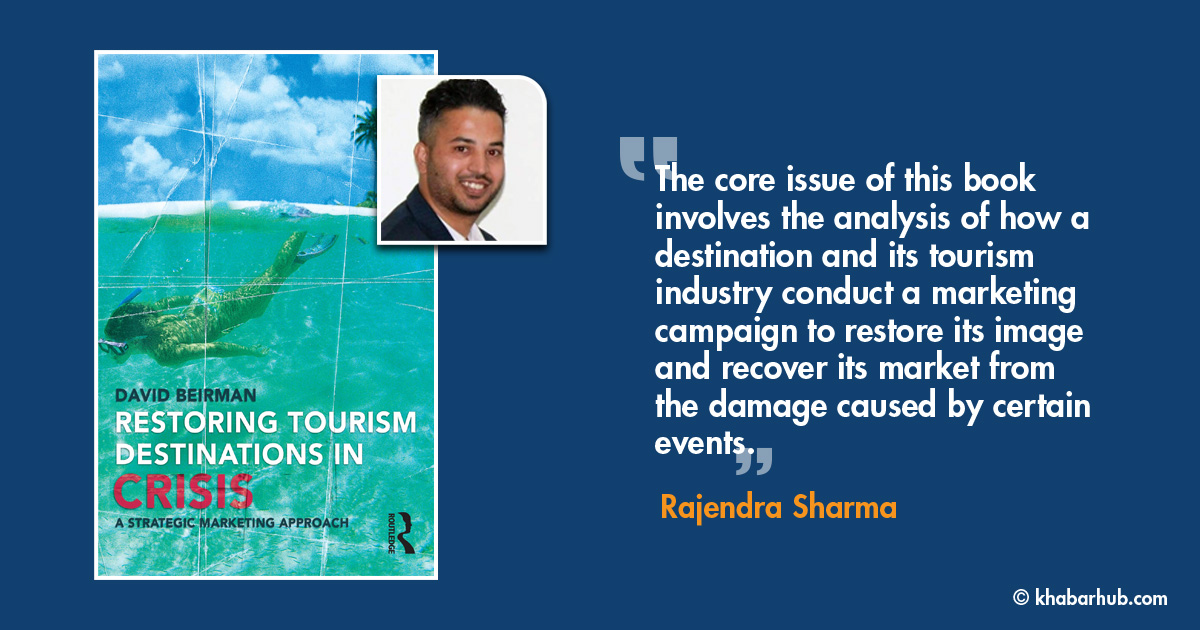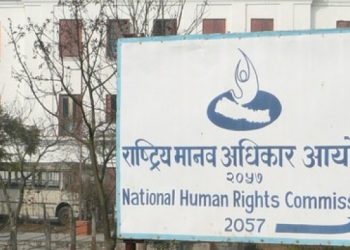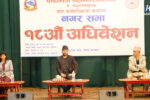‘Restoring Tourism Destination in Crisis: A Strategic Marketing Approach’ by David Beirman.
The book, ‘Restoring Tourism Destination in Crisis: A Strategic Marketing Approach’ primarily analyses the marketing dimension as it applies to specific crisis events.
It focuses on war, terrorism, natural disasters, crime wave and epidemics, and the appropriate restorative approaches.
The core issue of this book involves the analysis of how a destination and its tourism industry conduct a marketing campaign to restore its image and recover its market from the damage caused by these events (Page, 6).
Contingency management is discussed as a major component of tourism destination marketing. The fundamental steps to marketing management of a destination crisis are; identify the events/ problems as either a crisis or destination, establish a crisis management team and define the role, promote the destination during and after the crisis, and monitor recovery and analyze the crisis experience.
But, all the approaches only focus on marketing, not the issue of retraining and redeploying people whose livelihood is affected by a crisis (Page, xiii).
Maintaining an effective website and disseminating correct information via the website was one of the significant approaches adopted by Britain after the 2001 Foot- Mouth disease outbreak.
This book addresses three major themes.
First, a destination crisis is defined and the distinction between a destination crisis and hazard is explained.
The image and marketability of tourism destinations were seriously compromised in each of the case studies, the DECTCON (Defence Readiness Condition) system is introduced to classify the severity of a crisis in terms of the threat to destination marketability, and to sign an appropriate strategic response.
Secondly, the reader is presented with a detailed guide to the strategic management of in-crisis and post-crisis marketing programs and their incorporation in contingency planning.
Marketing restoration approaches emphasizing the establishment of strategic alliances between destination authorities, airlines (especially flag carriers), and all key principles of a destination’s tourism infrastructure are outlined.
Thirdly, and most importantly, it includes a broad range of international case studies. September 11, 2001 attack on World Trade Center and Washington DC, its blanket media coverage added another chapter of terrorism and the global tourism crisis.
Tourism development in the Philippines was conducted on a relatively ‘adhoc’ basis (Page, 251). Depicted as a low-cost high-value destination or best of the island campaign, the familiarization trip “Bring friend home” (Page, 255) is the specific approach to restore the market from the combined crisis.
To respond to the crisis government of the US had adopted these approaches; war on terror (Page, 52), solidarity induced tourism (Page, 54), the legislation of ‘Travel America Now Act’ (Page, 60), hotels and attractions offered substantial discounts and value-added offers, active campaign to host American and foreign travel writers to see the city for themselves, focused on the domestic market (Page, 63), sales-oriented approach and global marketing strategy (Page, 68).
Joint marketing among Turkey, Israel, Jordan, Palestine Authority (PA) – ‘regionalization”, public-private alliances, promotion as a pilgrimage destination for commemorating Christianity’s bimillennium and overseas seminar conducted by Misr Travel was ample approaches to restore the destination after the 1997 Luxor Massacre in Egypt (Page, 69-86).
Due to external threats and internal communal violence between Israel and PA, the tourism ministry in 2001 had to call all its PR specialist worldwide to a conference in Jerusalem to map a strategy for marketing, besides that Israel is promoted as MICE (meeting, incentives, conference, and exhibition) destination “STALWART market” (Page, 106), marketing least affected areas ‘Isolation tourism’, solidarity tourism among diaspora Jews community, Visiting Friends and Relatives (VFR) (Page, 108) and media house of Europe is used to promote Israel as a touristic destination but lacks public-private sectors synergy (Page, 116).
The denial strategy- assumption that if you ignore the problem, either it will go or nobody will notice (Page, 123), the Ceylon Tourist Board (CTB) had to suffer.
Open skies policies, foreign direct investment and isolation marketing had assisted to promote Sri Lanka as a low-cost high-value destination, high-yield niche markets, including the wedding and honeymoon market, health market, eco-tourism and the soft adventure market (Page, 125).
Tourism is regarded as a minor economic activity for South Africa. Niche marketing, devaluation of currency (RAND) and alliance with key stakeholders help to overcome the managerial failure (moral dilemma) of the authority.
Establishing a crisis management team to revive and restore the image and market was effective in and post-crisis of Turkey Izmit Earthquake (1999), Port Arthur Massacre (1996) and Philippines combined crisis (the 1990s).
The blanket media coverage and handling it in a good manner can be an effective approach to destination marketing.
Maintaining an effective website and disseminating correct information via the website was one of the significant approaches adopted by Britain after the 2001 Foot- Mouth disease outbreak.
The Visit Nepal 2020 was postponed because of the global crisis due to the Coronavirus pandemic. Nepalese economy is no exception, which was impacted badly by mobility restriction and lockdown.
“Sick man of Europe, Social Pariah, economic cataclysm, rural crisis…” were the word dubbed for the epidemic. British Tourism Authority with incorporating a three-stage marketing approach i.e. fact, information, and rebuttal (Page, 184), medium and long-term plans (Page, 185) marketing management of the foot-and-mouth crisis appears to have been successful.
Ostrich approach- ignore the problem rather than attempting to solve it, as an ostrich sticks its head in the sand so that he won’t see the risk (Page, 263).
Tourism development in the Philippines was conducted on a relatively ‘adhoc’ basis (Page, 251). Depicted as a low-cost high-value destination or best of the island campaign, the familiarization trip “Bring friend home” (Page, 255) is the specific approach to restore the market from the combined crisis.
In all case studies a media and public relations campaign, public-private sector alliances were directed in the recovery and restoration phase.
One of the important elements of this alliance is between national tourism authority/authorities and flag carrier airlines. Which were equally relevant during the COVID pandemic and post COVID restoration of the tourism destination in Nepal.
The Visit Nepal 2020 was postponed because of the global crisis due to the Coronavirus pandemic. Nepalese economy is no exception, which was impacted badly by mobility restriction and lockdown.
This Himalayan country has multiple possibilities as the world’s few tourism destinations. But the government must have a specific strategy to restore the tourism destination. In post-COVID tourism restoration, ‘Vaccine Tourism’ can be the new avenue for South Asian tourism.









Comment